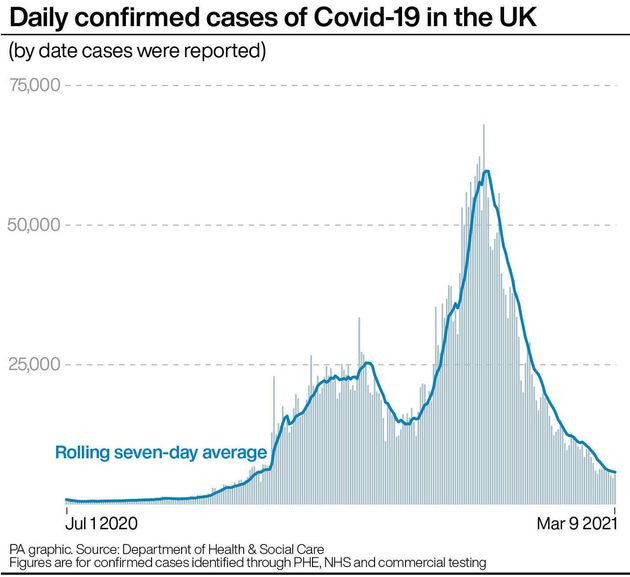Covid cases continue to fall across England in all but a handful of areas, as the country prepares for the gradual process of reopening.
This week saw students returning to schools, the first phase in Boris Johnson’s “cautious but irreversible” lifting of lockdown.
Any rise in cases from the move won’t be apparent for a number of days – but six areas of England have seen an increase in the number of reported infections anyway.
These most recent figures are for the seven-day rolling average up to March 7, and the decrease is a comparison with the seven-day rolling average to the previous day.
- Kingston-upon-Thames 25% rise in cases (now 48.4 cases per 100,000 people)
- Torbay 11% (37.4)
- Rotherham 7% (146.9)
- Windsor and Maidenhead 6% (49.5)
- Devon 2% (24.4)
- North Lincolnshire 1% (90.5)
Covid levels fell or remained the same everywhere else in the country.

At the peak of the second wave of cases, in the seven days to January 5, the highest rate in the UK was 1,635.5 per 100,000 over the course of seven days in the London borough of Barking & Dagenham.
The current rate in Barking & Dagenham is 56.8.
These are the places in England with the lowest rates of coronavirus as of March 7, the latest figures available from NHS Digital.
- Isle of Wight 9.9 cases per 100,000 people
- Cornwall and Isle of Scilly 11.9
- East Sussex 18.3
- Lewisham 20.9
- Herefordshire 21.8
- Lewisham 22.4
- Islington 24.3
- Devon 24.4
- Bromley 25
- West Berkshire 25.2
- Haringey 25.3
- Bath and North Somerset 26.4
- Brighton and Hove 27.2
- City of London 27.5
- Bexley 27.8
- Gloucestershire 29
- Suffolk 29.6
- Havering 29.7
- Southwark 29.8
- Cumbria 29.8
- Enfield 30
- Oxfordshire 30.2
- Camden 30.7
- Medway 31.2
- Bournemouth 31.4
But scientists are eyeing an even lower threshold.
Looking ahead to the upcoming gradual reopening of society, one scientist told HuffPost UK last month the country still has a long way to go in order to stay on top of the pandemic.
Dr Kit Yates, mathematical biologist at the University of Bath, said: “In terms of having everything opened up and being able to keep on top of cases using Test and Trace, we need to be down to 10 cases per 100,000 people per week.”
“That’s where we need to be if we want to stamp down on outbreaks.”
The government has repeatedly refused to commit to specific thresholds for lifting lockdown, pointing instead to four general tests it will use.
So where are we right now? Although it varies across the country, on average we’re at 57.5 cases per 100,000 people.
Here are the 10 places in England with the highest case numbers.
- Kingston upon Hull 151.3
- Rotherham 146.9
- Barnsley 139.3
- Bradford 138.4
- Peterborough 132.5
- Leicester 132.1
- Wakefield 127.8
- Hartlepool 119.6
- Rochdale 116.5
- Salford 108.2
Elsewhere, new research suggests the Kent variant may be up to twice as deadly as previous strains of coronavirus.
The more infectious variant, B117, which swept across the UK at the end of last year before spreading across the world, may be between 30% and 100% more deadly, according to a new study.
Epidemiologists from the Exeter and Bristol universities said the data suggests the variant is associated with a significantly higher mortality rate among adults diagnosed in the community compared with previously circulating strains.

